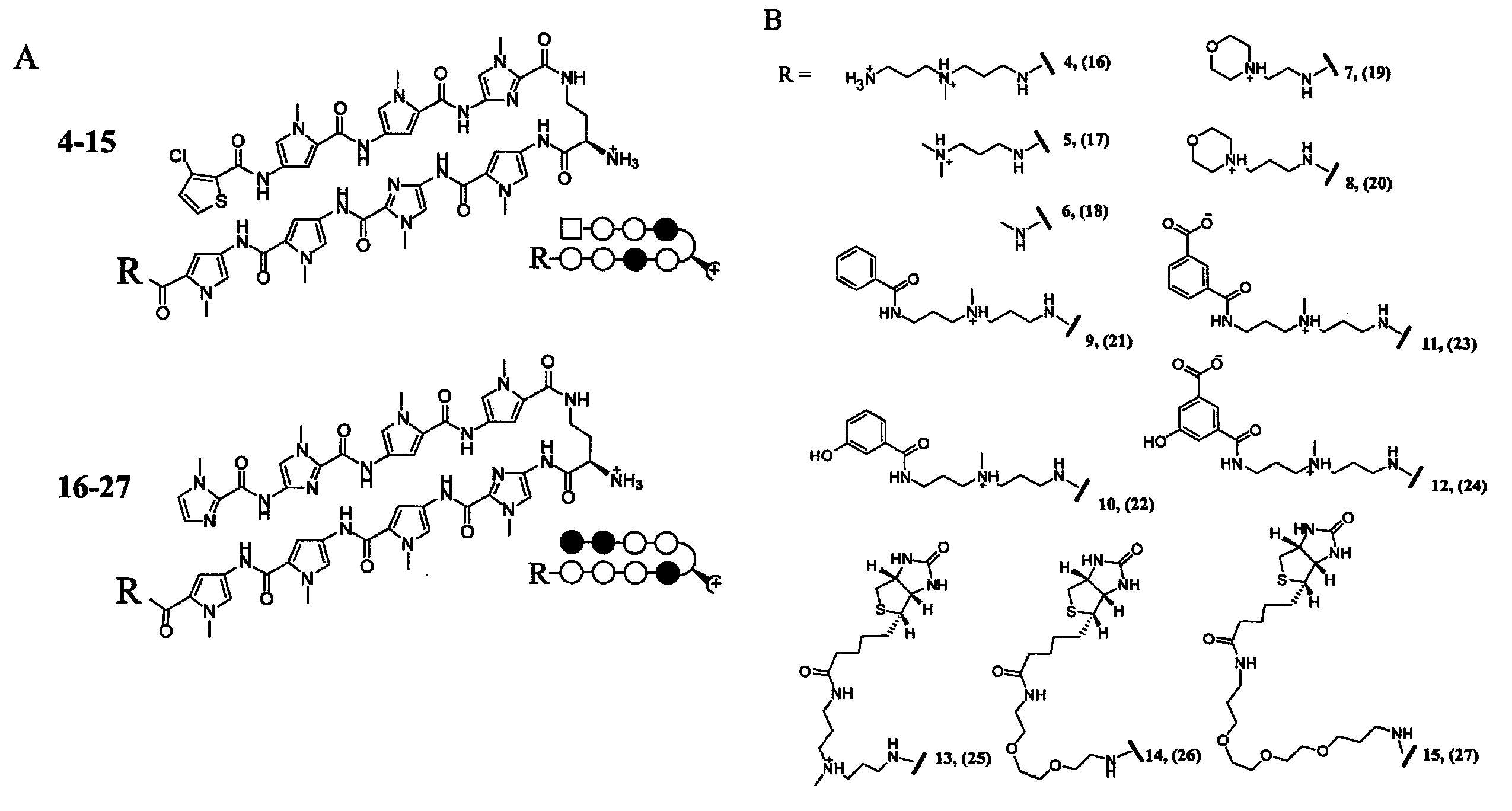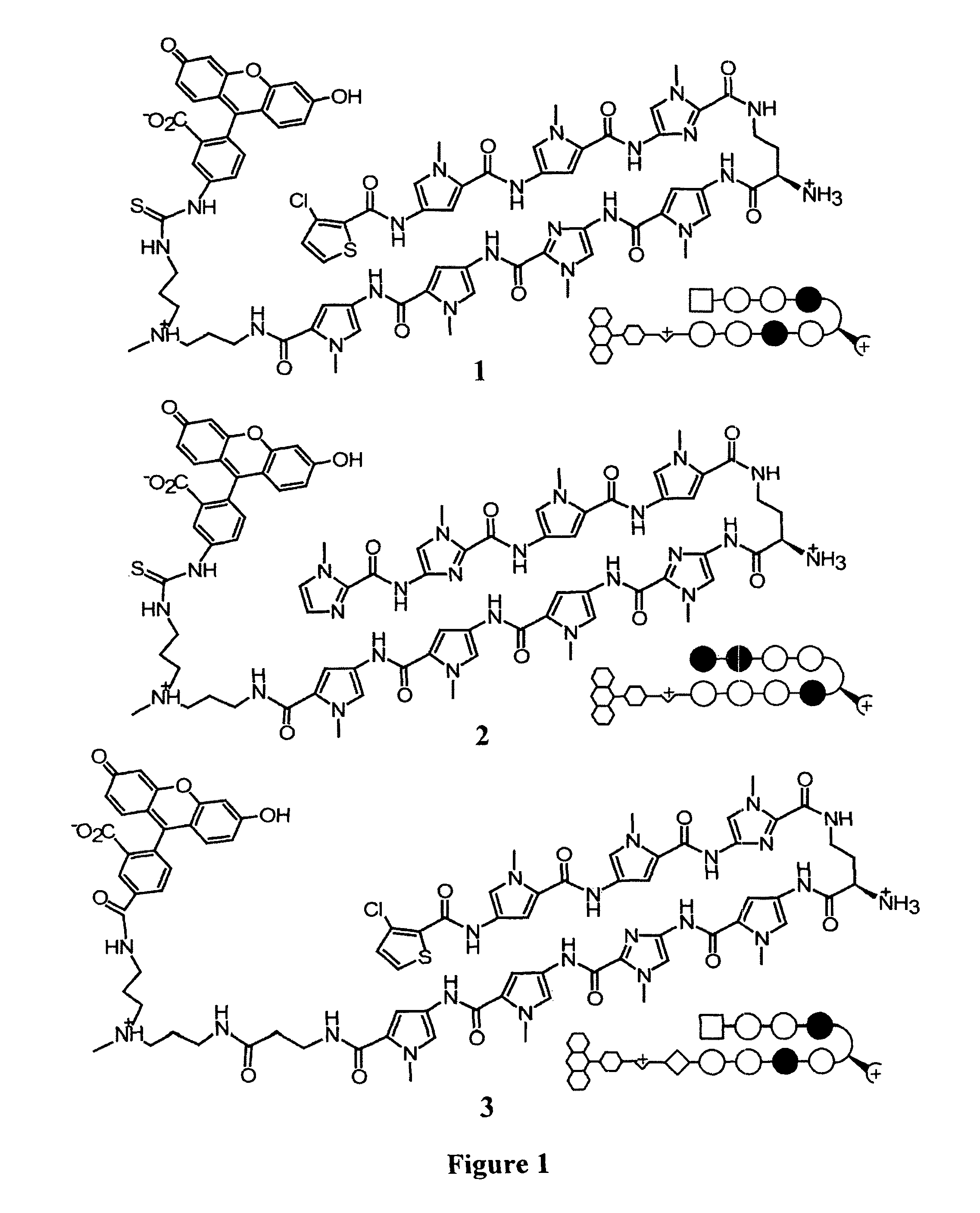Polyamides with tail structures capable of binding DNA
a technology of polyamides and structures, applied in the direction of peptides, drug compositions, peptides, etc., can solve the problems of limited ability of polyamides to enter cells and especially their nuclei, difficult to facilitate the delivery of polyamides to their target sequence, and limited ability of polyamides to be limited to structures, etc., to improve the ability of polyamides and improve disease symptoms
- Summary
- Abstract
- Description
- Claims
- Application Information
AI Technical Summary
Benefits of technology
Problems solved by technology
Method used
Image
Examples
example 1
Improved Nuclear Localization of DNA-Binding Polyamides
[0118]1.1 Abstract
[0119]Regulation of endogenous genes by DNA-binding polyamides requires effective nuclear localization. Previous work employing confocal microscopy to study uptake of fluorophore-labeled polyamides has demonstrated the difficulty of predicting a priori the nuclear uptake of a given polyamide. The data suggest that dye identity influences uptake sufficiently such that a dye-conjugate cannot be used as a proxy for unlabeled analogs. Polyamides capable of nuclear localization unaided by fluorescent dyes are desirable due to size and other limitations of fluorophores. Recently, a polyamide-fluorescein conjugate targeted to the hypoxia response element (HRE) was found to inhibit vascular endothelial growth factor (VEGF) expression in cultured HeLa cells. The current study used inhibition of VEGF expression as a biological read-out for effective nuclear localization of HRE-targeted polyamides. We synthesized a focuse...
example 2
Modulating Hypoxia-Inducible Transcription by Disrupting HIF-1-DNA Interface
[0192]2.1 Abstract
[0193]Transcription mediated by hypoxia inducible factor (HIF-1) contributes to tumor angiogenesis and metastasis but is also involved in activation of cell-death pathways and normal physiological processes. Given the complexity of HIF-1 signaling it could be advantageous to target a subset of HIF-1 effectors rather than the entire pathway. We compare the genome-wide effects of three molecules that each interfere with the HIF-1-DNA interaction: a polyamide targeted to the hypoxia response element (HRE), siRNA targeted to HIF-1α, and echinomycin, a DNA-binding natural product with a similar but less specific sequence preference than the polyamide. The polyamide affects a subset of hypoxia-induced genes consistent with its binding site preferences. For comparison, HIF-1α siRNA and echinomycin each affect the expression of nearly every gene induced by hypoxia. Remarkably, the total number of g...
PUM
| Property | Measurement | Unit |
|---|---|---|
| dissociation constant | aaaaa | aaaaa |
| diameter | aaaaa | aaaaa |
| affinity | aaaaa | aaaaa |
Abstract
Description
Claims
Application Information
 Login to View More
Login to View More - R&D
- Intellectual Property
- Life Sciences
- Materials
- Tech Scout
- Unparalleled Data Quality
- Higher Quality Content
- 60% Fewer Hallucinations
Browse by: Latest US Patents, China's latest patents, Technical Efficacy Thesaurus, Application Domain, Technology Topic, Popular Technical Reports.
© 2025 PatSnap. All rights reserved.Legal|Privacy policy|Modern Slavery Act Transparency Statement|Sitemap|About US| Contact US: help@patsnap.com



